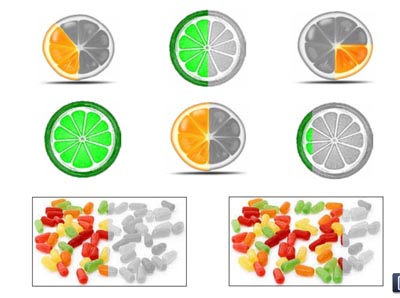Discussion/Introduction
We’ve just celebrated Easter, and it’s the perfect time for a lesson on data collection and representation! After all, how else could the Easter Bunny get all the information he needs to bring perfect Easter baskets to every household, if it weren’t for a bit of mathematical genius?
Objective
Students will learn how to organize data with up to three categories and represent it on a simple grid. They’ll learn to interpret such graphs, and practice writing statements answering questions on data recorded.
Supplies
- Bunny ears, if you want to be fun and go in character!
- 1st Grade Data Representation Worksheet, one per student.
Methodology/Procedure
You want to start by giving your students the lay of the land. 1st graders like to know what’s what, and there are many children who learn better if they can see a ‘road map’, so to speak, of where they’re going and what they’re meant to do. So start with a discussion like this one:
There’s an enormous amount of information in the world, and part of our job as intelligent people is to gather that information, organize it so that it is in a way we can use, and interpret it. It comes to us like a big unorganized pile, and our job is to take this messy information and make it nice and neat and easy to use.
Today we get to learn how to do just that, and to make it extra fun, let’s start with as story. Can anyone tell me which holiday has just been (or is coming up)?
Easter!
Yes! And who comes to visit Easter morning, before you’ve even got up?
The Easter Bunny!
You’re right, it’s the Easter Bunny! He comes to bring yummy treats or special little presents, but he doesn’t bring the same thing to each house; somehow he needs to know what is the perfect Easter surprise for every little girl and boy.
How many little girls and boys does the Easter bunny visit?
Give your students a chance to discuss the numbers, as specifically or vaguely as they like. The take away point: Lots and lots!
Now put on your bunny ears: this is when the fun begins! You can get into character as much or as little as you like, depending on your personal teaching style; but the children will certainly appreciate you unbending a little and helping the pretend along with a few apt characterizations.
Let’s pretend I’m the Easter bunny, and pretend I have a bag full of special treats. I’ve got white chocolate eggs and brown chocolate eggs, and I’ve got some plastic eggs filled with other fun surprises for children whose parents don’t want them to get too much candy. Suppose that I have a little notebook, and well before Easter, I start making plans so that on the big day I’ll know what I have to deliver where. I could go hide in everyone’s back yard and listen till I found out what kind of surprise they’d prefer, but since we’re all in class now, I’ll just ask.
Starting with the front, ask the children which type of Easter surprise they would prefer: brown chocolate, white chocolate, or plastic eggs with little surprises. Write the information on the chalkboard in complete sentences, for instance “Leanna likes brown chocolate eggs best.” Go through six or seven children, and then stop and look at the board. Ask your students how much paper it would take for the Easter bunny to take notes on everyone he brought gifts to, and whether, when it was all written down, it would be easy for him to see how many brown chocolate eggs he needed and if he needed more plastic eggs than white chocolate eggs or more white chocolate than plastic eggs.
Give the students a chance to discuss this; the conclusion, if you’ve done it right, should be quite simple:this is messy and difficult! Talk about what might make it easy. Some ideas they might come up with are neater handwriting, or using different columns (or notebook pages) for each of the three categories. Then tell your students you want to show them a super-easy way to write down information so it’s easy to look up after.
Draw a large rectangle, and divide it into three rows and two columns; your first column will be used for labels and can be much narrower than the second. In the first column, write the labels. “Prefers brown chocolate”, “Prefers white chocolate”, “Prefers plastic eggs “ Go through the class again, asking the same questions and noting names in the appropriate columns.
Tell them your columns are called a graph, and ask which way is easier to collect information: noting it in a graph, or writing about it? They should be pretty unanimous that the graph is easier.
What about if you need to know which to pack more of, white chocolate, brown chocolate, or plastic eggs? Show your students how they can find this information in a glance from the graph. Drawing it from the written record is time consuming and difficult.
Ask how many baskets with plastic eggs you would need if you were delivering Easter baskets to all the students in the class.
Now give the students the handout, and ask them what three types of surprises they’d want to bring if they were an Easter bunny with the power to bring gifts to all their class-mates. Guide them in filling out the first column, and have them survey the other students in the class, writing down the names in the appropriate rows.
Allow them to take turns showing their graph and sharing the information with the class. Ask which surprise most students preferred, which surprise fewer students were interested in, and how many students wanted a particular surprise. As an added exercise, you could have the students write three or four sentences describing their findings in their math journals. This will help cement the work they’ve done in class.
Common Core Standards
This lesson is aligned to the Common Core State Standards for Mathematics. In 1.MD.4, The Common Core Standards read
1.MD.4 Organize, represent, and interpret data with up to three categories; ask and answer questions about the total number of data points, how many in each category, and how many more or less are in one category than in another.
Web Resources/Further Exploration
This lesson plan (available here as a pdf download ) is only one in a series of engaging, fun math lesson plans coordinated to the Common Core and easy to use in the classroom. Browse through the other lessons at https://www.mathwarehouse.com/topic, and enjoy the wealth of other math resources available at Mathwarehouse.com
Other Resources
Simplify Fraction calculator




